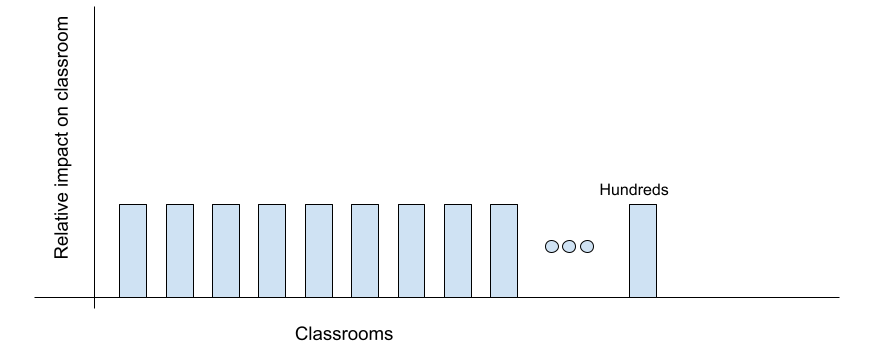Making a genuine impact in EdTech Part 3:
My Piece of the Puzzle
In the first two parts of this series, we discussed the importance of collaboration and empathy among stakeholders in the EdTech landscape, along with lessons learned from bridging the gap between research and development. In this post I’ll discuss my transition from a learning scientist at a research firm to a member of an EdTech company (the story of forging out on my own is a story for another time).
Research and Real-World Impact
During my two decades at SRI, I spearheaded a variety of projects aimed at scaling learning science research to reach large numbers of teachers and students. My design-based research projects, for instance, involved creating curriculum and professional development for hundreds of teachers annually, with one project impacting over 100,000 students over four years. This was a different type of impact than I had when my team at SRI consulted with EdTech companies. There, we could nudge companies towards smaller incremental changes that ultimately affected hundreds of thousands of classrooms.
This led me to a simple realization about the tradeoff between the depth and breadth of impact I was having as a researcher. I found these overly simplest representations useful:
My impact through design-based research (a medium impact in the classrooms of hundreds of teachers):
My impact through edTech consulting (small impact in the classrooms of hundreds of thousands of teachers):
My design-based research offered deeper impact within a smaller scope, while our EdTech consulting efforts provided a broader reach with potentially smaller impact on each classroom. Driven by my goal of applying learning science research on a larger scale, I decided to shift my focus to where I could try to have a larger impact on many classrooms.
So, off to the world of EdTech I went!
Navigating the EdTech Landscape
While I successfully made the move to a large EdTech company, the transition wasn't without its challenges. There was an inherent skepticism that someone from a research background could adapt to the fast-paced, Agile-driven world of large-scale development. Common concerns included researchers taking too long to make decisions, being disconnected from real classrooms, not understanding the pace of development, and needing to be the smartest person in the room.
My advice to fellow researchers entering the EdTech space: don't be that person! Embrace the need to ship, scale, and grow the customer base. However, you can insist that this is done with integrity and a genuine focus on learning. Find your allies within the company, those who share your passion for student learning, and build strong relationships. Engage in open dialogue to foster a shared understanding of how to best support students, while recognizing the real constraints imposed on developers and teachers.
Leveraging Expertise for Change
Learn the decision-making processes and leverage your relationships to become part of them. For instance, I quickly discovered that learning science wasn't always a top priority in the design process. Instead of being discouraged, I took an inquiry-based approach to understand the underlying reasons. I discovered that, while companies often adhere to state mandates for frameworks like Universal Design for Learning, web accessibility, and supporting multilingual learners (all of which are obviously important!), explicit requirements for learning science alignment are rare. And education companies will organize around state mandates!
This insight led me to search out and collaborate with internal experts in the various frameworks. Through that I learned that they were not satisfied with the current processes: these experts created their own guidelines and had their own input into product design, but each felt siloed. By bringing together the experts as a set of allies, I was ultimately able to lead a cross-division effort that used learning sciences as the foundation for a unified approach to incorporating best practices from each framework (I wrote about an abbreviated version of this approach in a prior post).
Another pivotal moment opened up when I learned about the process for user testing. Initially, the protocols focused on traditional productivity measures. As a result the user tests would often overlook indicators of actual learning, and some positive indicators of learning, such as productive struggle, would be perceived negatively (because any user struggle or frustration was perceived as negative). By integrating a learning sciences perspective, we shifted the focus towards student learning, resulting in meaningful product revisions that wouldn't have happened otherwise. In addition, my modifications to the user testing protocol, as well as suggestions to improve the products, fit within the 2-week sprint timeframe that we were beholden to. As a result my participation was not viewed as an outside imposition, but was often requested as a valued part of the user testing process.
Embracing the EdTech Journey
While my personal experience highlights a successful transition, I'm not suggesting that all academics or researchers should make the leap into industry. However, for those who do, remember that the impact will be different. You'll need to adapt to the demands of shipping real products for diverse classrooms while remaining committed to your passion for student learning.
Collaboration and empathy are key. Presume positive intent, seek understanding, recognize constraints, take the long view, and always center your efforts on the learner. By doing so, you can truly make a genuine impact in the EdTech landscape.


